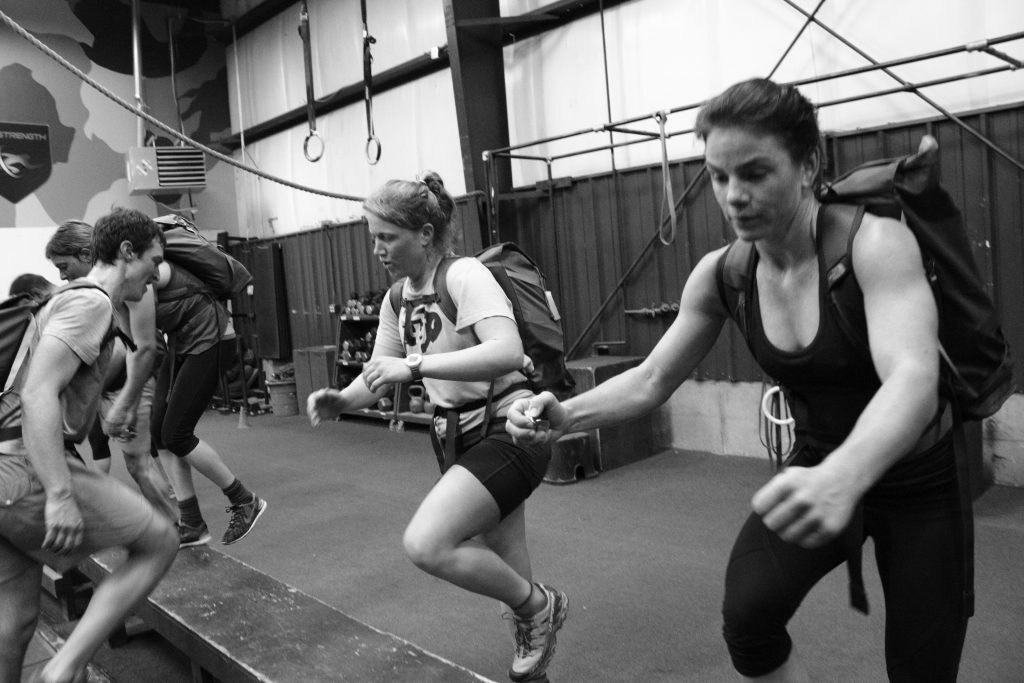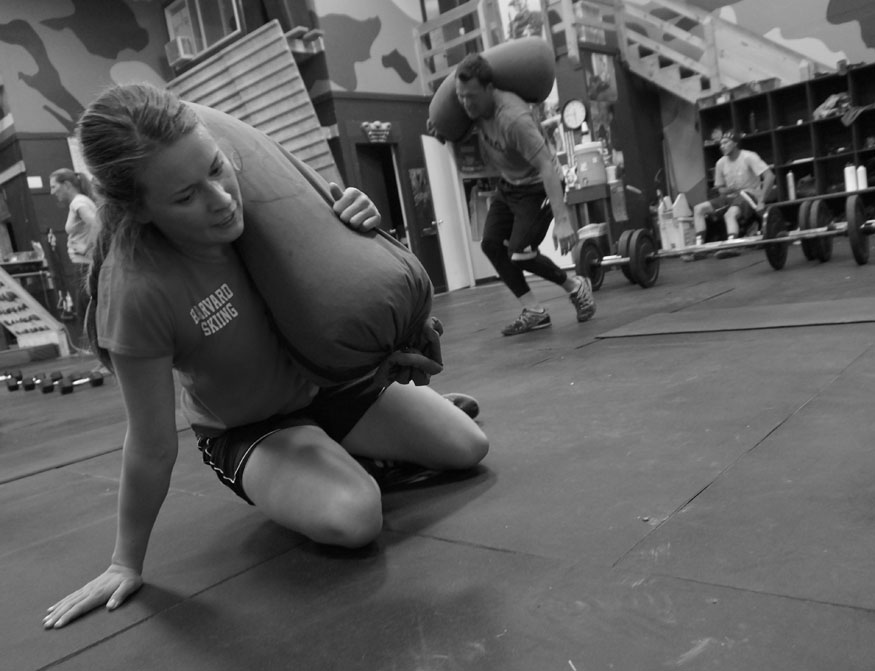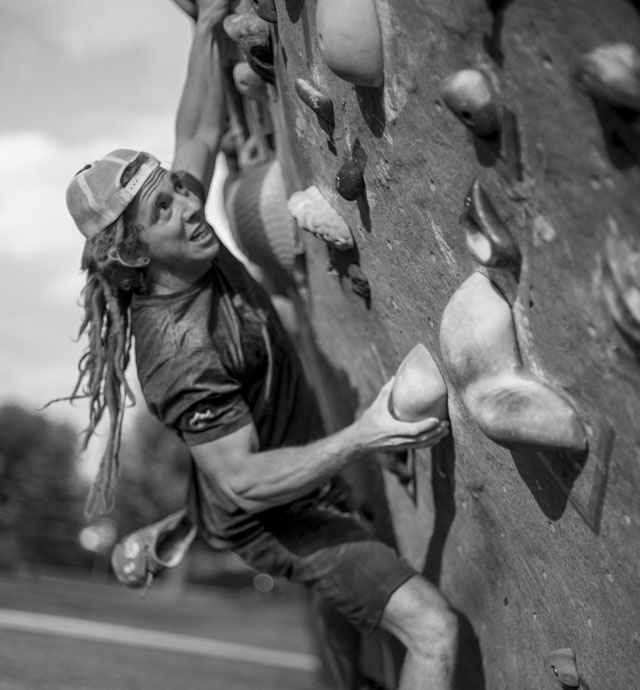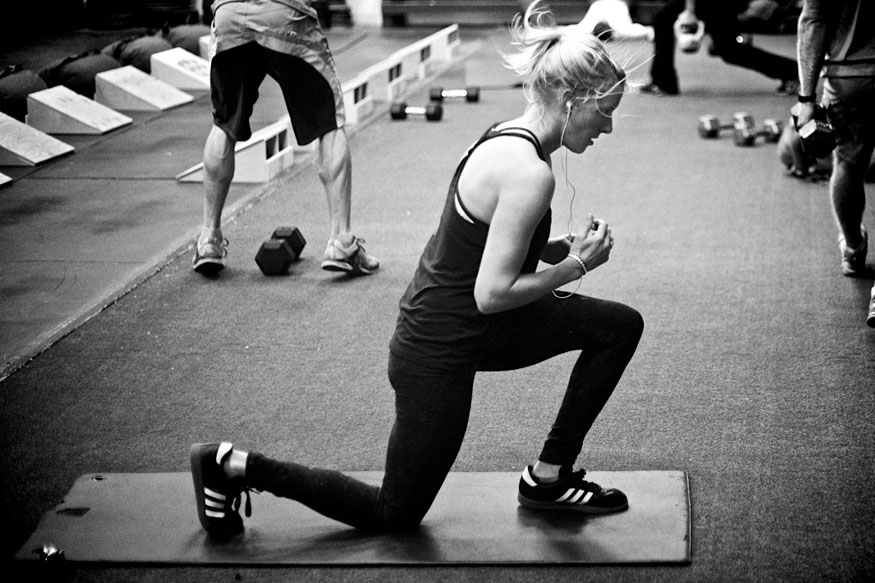
By Rob Shaul
1) Loaded Step Ups
Loaded step ups are a functional, transferable, and no-excuse way to directly train hiking uphill under load – a foundational fitness demand for all mountain sports.
Loaded step ups can be completed anywhere. Mountain athletes living in flatlands or away from any vertical terrain can train uphill movement under load with a backpack, filler and a 15-18 inch step or bench.
The bad news is step ups are pure drudgery, but with one exercise you train the legs, core, and lungs in a sport-specific manner. We try not to load more than 45# and use a step higher than 17 inches.
What is a good step up assessment? Use a 17-inch step, 40# (18kg) pack and go for 40 minutes as hard as possible, for total reps. Each step counts as one rep. Our top, professional mountain athletes score 1,000+. At a 17″ step, this is the equivalent of climbing 1,416 vertical feet in 40 minutes with a 40# pack.

2) Sandbag Getups
Sandbag getups are the best overall exercise to train a mountain athlete’s “Mountain Chassis” – leg, core and lungs. With each rep, the athlete works core flexion, rotation and extension. He or she also must do a loaded lunge or squat to stand up, and finally, at high reps, his heart and lungs will be burning through the work capacity hit.

3) Bouldering V-Sum
After a decade of programming for mountain athletes, in general we’ve found the gym is an inefficient place to train technique, and the mountain, or rock, is an inefficient place to train fitness. The one exception to this rule is the Bouldering V-Sum.
I learned this incredible training tool from Steve Bechtel, an incredible climber and performance coach based in Lander, Wyoming.
When athletes first start rock climbing, their fitness generally greatly outweighs their technique. As they learn the sport, their technique catches up, and when they reach the ability to onsite 5.10, their climbing specific fitness (finger/grip strength) and technique become nearly balanced. “Nearly” is key, as at any one time, fitness is good and technique holds them back, or technique is there and fitness is holding them back.
We’ve found the Bouldering V-Sum the one drill/protocol which concurrently trains both climbing-specific fitness and technique. If climbers only get one day per week in the gym, I recommend they spend that time completing a Bouldering V-Sum every week.

4) Scotty Bobs
Most mountain movement begins and ends with the legs, and upper body fitness is not key. Even for alpine, ice and rock climbers, finger and grip strength is far more important to sport performance than upper body pulling strength.
In our base fitness programming for mountain athletes, strength emphasis is on the “mountain chassis” – legs, lungs and core – but we don’t ignore upper body work.
Why I chose the Scotty Bob for this list is its efficiency. 1x Scotty Bob = Push Up/Right Hand Row, Push Up/Left Hand Row – so with each rep I get two pushes and two pulls – super efficient!
We generally load men with 25# dumbbells and women with 15# dumbbells. The “crux” of the exercise, when athletes get tired, is the push up – hands are on the dumbbells and so to touch their nose or chest athletes must work the full range of motion. Even for our fit, experienced, tactical lab rats, 6 rounds of 5x Scotty Bobs (10x push ups total) is killer.
This is a great, simple, upper body press/pull exercise.

5) Leg Blasters
Loaded step will build your quads for uphill hiking, but even more intense – and damaging, is the downhill. Uphill hiking demands “concentric” strength … lengthening of the quads.
Coming down hill demands “eccentric” strength …. shortening of the quads. When hiking down hill – or skiing downhill, gravity “bounces” the athlete down the mountain and legs act to prevent gravity from pushing you into the mountain.
With each step down hill or ski turn, gravity tries to force the athlete into the ground and legs must absorb this force, slow it, stop and bound back up.
The soreness you feel after the first hike of the spring is not from the uphill, but from the down hill …. it’s the downhill that gets you.
Leg blasters are an intense, complex of bodyweight leg exercises which are super effective at training eccentric leg strength. We’ve deployed leg blasters effectively for nearly a decade to train mountain athletes for alpine skiing and dowhill hiking as well as soldiers deploying to mountainous regions of Afghanistan.
Want More? Check Out MTI’s Alpinist Fitness Assessment
